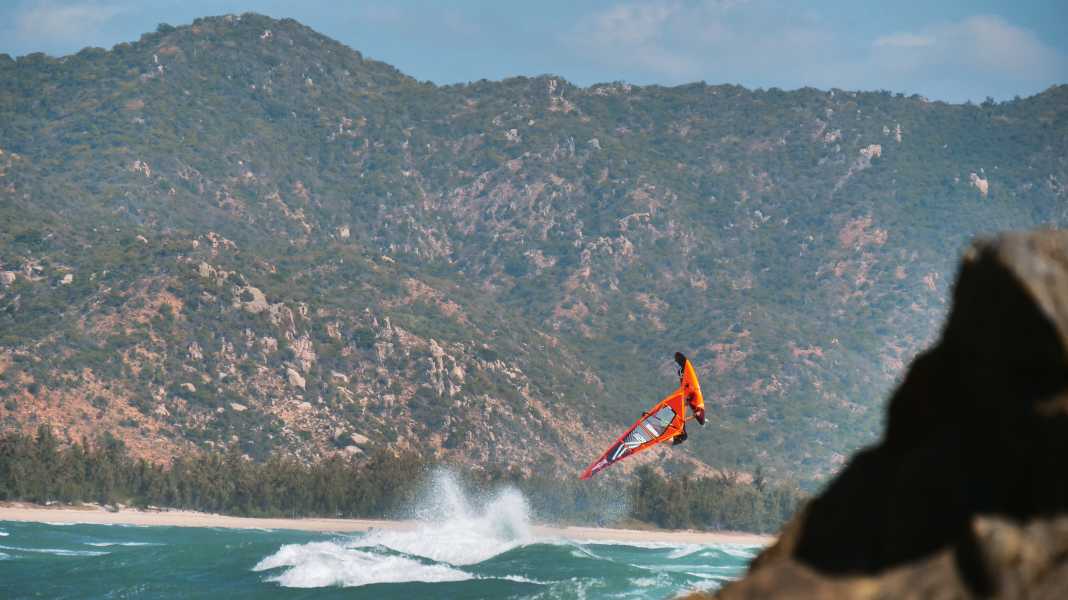
Between the question "Vietnam? Can you windsurf there?" and a flight ticket in my name in my pocket was only a few days away. My friend Tony Möttus from Estonia, who has also regularly taken part in the Freestyle World Cups for several years, had put a flea called "Vietnam Surf Camping" in my ear and told me about surfing in shorts, dream beaches and endless wind.
In the end, it was mainly curiosity about something new that persuaded me to book a ticket. As beautiful as Cape Town is, I couldn't imagine spending the third winter in a row there. One thing up front: I haven't regretted the decision to try something new for a second!
When I leave the airport in Ho Chi Minh City, formerly Saigon, I get a bit of a culture shock: mopeds everywhere, fruit and vegetables I've never seen before, let alone tasted, a 35-degree wall of hot, humid air and exhaust fumes, and the hectic pace of the Asian metropolis of seven million people.
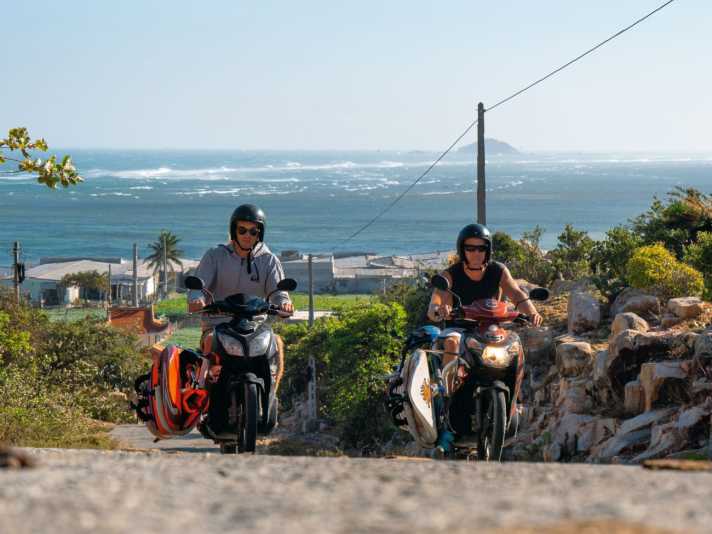
As my perplexity subsides, I quickly realise that the people here are very peaceful and helpful, but also very reserved - almost a little too reserved for my taste. For example, you shouldn't be surprised if you walk into a small, empty shop and the shop assistant looks at you but doesn't greet you - not even with a brief nod of the head. I later learnt from Tony's local friend that this is not meant to be rude or even nasty, but that people here often don't greet each other so as not to disturb the other person. Hard to imagine, isn't it?
The Vietnamese currency, the dong, is not only difficult to imagine, but also hard to get to grips with at first. Dong translates as "copper" - even though there are no coins, only paper money. The dong is one of the most "worthless" currencies in the world. The smallest banknote in circulation is the 200 dong note, which is equivalent to around 0.7 cents. It's easy to lose track of your wallet at the till. Away from the big city, the hustle and bustle gives way to a soothing originality. Tony's Surf Camp is located twenty kilometres north of Phan Rang, a small provincial town about two and a half hours' drive north of the well-known tourist resort of Mũi Né, which also hosted a PWA World Cup in 2011. In contrast to Mũi Né, there are only a few tourists around Phan Rang, but much more wind and significantly better windsurfing conditions.
The majority of the locals here live in small huts next to their chicken coops and their own fields. For the most part, they cultivate these in the same way as we did 100 years ago - everyone is up and about in the early hours of the morning. Despite all the originality, the effects of globalisation are also noticeable here - in the form of plastic waste, which tarnishes the idyll of the postcard beaches time and again. However, because the surf camp where I will be staying for the next few weeks borders directly on a large national park, the rubbish problem here is fortunately limited.






The camp itself consists of an open restaurant, a storage room for equipment, fifteen residential tents on the beach, showers and toilets. It is mainly visited by tour groups, predominantly kiters, who make a multi-day trip from Mũi Né to the north. But don't worry, there are still only a few umbrellas on the water at the surrounding spots.
Only in the lagoon, directly in front of the camp, do windsurfers have to make arrangements - there is plenty of space. Given the perfect combination of flat water in the lagoon and waves on the reef in front, there's nothing to stop you from spending your entire holiday here. If you still want to explore the other spots in the area, you should hire a simple moped with a surfboard holder attached as a means of transport. There is also no alternative, as hire cars are hard to come by.
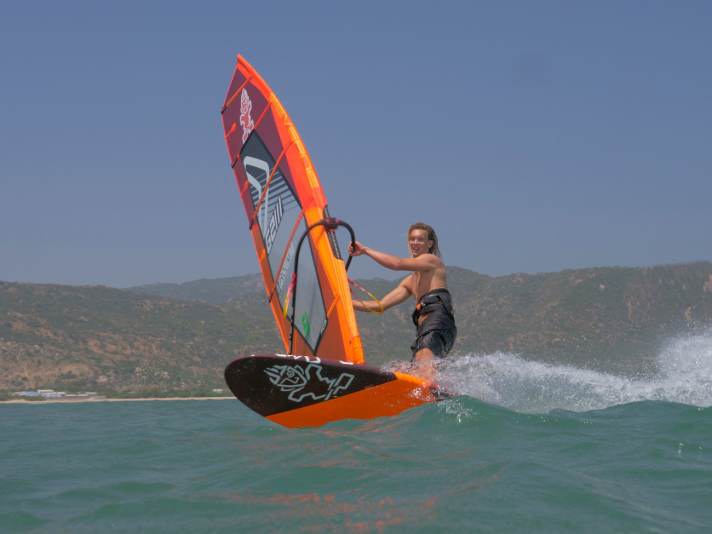
In contrast to the lagoon, the spots away from the camp are not for amateur surfers who like it as uncomplicated as possible - large tidal differences and sometimes rocky entrances are not without their challenges. Those who are prepared to get involved will be rewarded with a great surfing experience, a sense of adventure and lasting impressions.
I would now like to introduce you to eight spots that offer everything from waves and bump & jump to flat water. On site, you can contact Tony at any time, who is at the camp throughout the season. He knows all the spots and can tell you all about the wind, tides and dangers.
General information
JourneyVisa: A visa is required to enter Vietnam, so it's best to book one with your travel agent. Ho Chi Minh City can be easily reached from Europe with airlines such as Lufthansa, Qatar Airways, Emirates, Turkish Airlines and others, often with a stopover in Doha, Singapore or Kuala Lumpur. Prices range between 600 and 1100 euros, depending on the season. As always, you should check the baggage conditions for surf baggage, register and pay for it in advance. The nearest airport to the surf camp is Cam Ranh, 70 kilometres away. It is possible to take a domestic flight from Ho Chi Minh City to Cam Ranh (one hour flight time), but as the planes are very small, you may have problems taking surfing luggage with you. The best option is as follows: Fly to Ho Chi Minh City and then take a booked transfer (350 kilometres, takes about 6.5 hours) directly to the spot. Transfers are available from Vietnam Surf Camping ( www.kitesurfing-vietnam.com ) or with www.liveinmuine.com . On site, these mopeds are the number one means of transport and can be booked directly through the Vietnam Surf Camp.
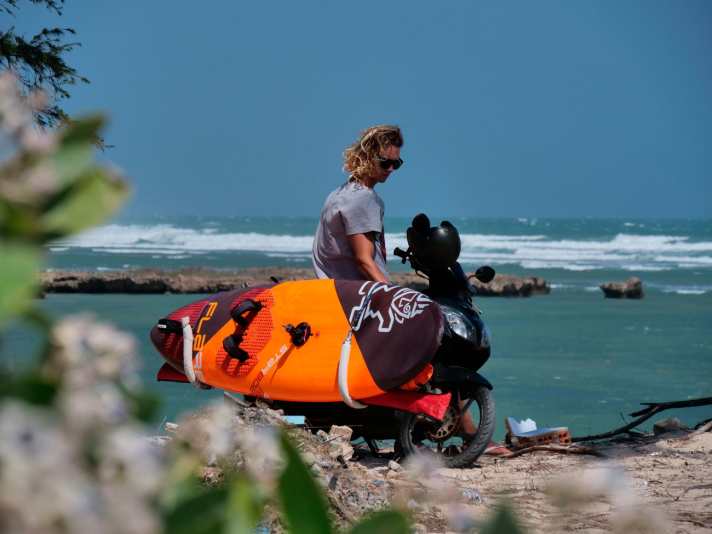
Wind, weather & neoprene: The general weather situation in Vietnam is determined by the monsoon. As cold air masses sink over the Asian continent between Siberia and the Himalayas in winter, air from the resulting high-pressure area flows towards the warm Pacific. In the wind season from mid-November to mid-April, the resulting NE wind blows very reliably and, thanks to local effects, with a force of between 15 and 40 knots. There are only a few days when the wind remains below 15 knots at midday, and the wind frequency in the region is likely to be around 80 per cent during the season. The windiest months are December and January. Windguru (Phan Rang - My Hoa Beach) or www.windy.tv give very good wind forecasts. The water is very warm (25-29 degrees) and you can only windsurf with board shorts. Nevertheless, a neoprene top or thin shorty should not be missing from your luggage, as it can get chilly in the evenings on cooler days. The area around Phan Rang is the driest in the whole of Vietnam and so the heat during the day combined with the wind is very bearable. Anyone arriving in Ho Chi Minh City to the south will walk out of the airport into a wall of hot, humid air at 35 degrees and will hardly believe how pleasant the climate is just 350 kilometres further north. At night it usually cools down to 20 degrees here, so you should definitely bring a jumper and a thin windbreaker.
The official rainy season ends at the end of November/beginning of December and the weather is now becoming increasingly stable. But even after that, you have to expect changes in the weather from time to time, as smaller typhoons can still move towards the Philippines in the South China Sea at this time of year and affect the weather in the coastal regions of Vietnam.
Tides & Waves:The tides play an important role at many spots here. On "Tidechart" the expected water levels within the tidal cycles are clearly displayed. In the spot information you can read which water level is required at which spot in order to be able to get on the water without touching the bottom. Due to the tidal differences of around two metres, it can happen on some days that you can only windsurf in the lagoon in front of the camp for a short period of time or have to walk out to the offshore reef through (too) shallow water. Neoprene shoes are therefore recommended for people with sensitive feet, as the ground is sometimes rocky. Waves only arrive on the coast in combination with strong winds. These are usually moderate with heights of one to two metres and can also be mastered by less experienced surfers. However, if the NE wind blows at over 25 knots for one or two days or a small typhoon is on its way in the South China Sea, the swells can reach up to four metres in height. As soon as the wind dies down, the conditions are much more moderate the next day.
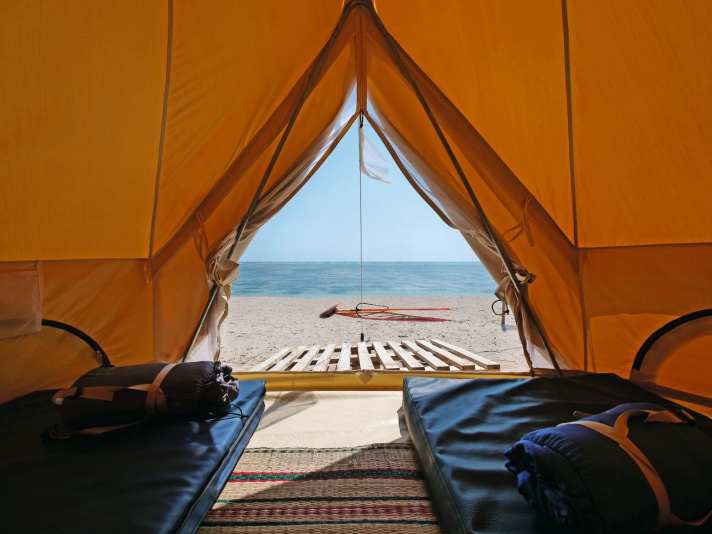
Living & Camping:There are generally two options: Either you decide to stay directly on the beach at Tony's Camp ( www.kitesurfing-vietnam.com ) in one of the simple tents, or you can book a more comfortable stay at a resort in the town of Phan Rang, around 20 kilometres away - for example the Long Thuân Resort & Spa ( www.longthuanresort.com.vn ) or the Aniise Villa Resort ( www.aniisevillaresort.com ). Not only do you live comfortably here, you can also go straight onto the water "on your doorstep" on the beautiful beach.
Surf stations: The surf school attached to the surf camp has an up-to-date but very limited range of equipment. Sails (4.0 to 5.5 square metres) and boards (85-115 litres) from Severne can be hired. It is advisable to bring your own equipment if you want to visit the spots away from the surf camp.
Alternative programme: A day trip by moped up the coast to the north (Binh Tien) is a must. The landscape is marvellous and you can stop at a waterfall for a swim halfway up. Tony also rents out surfboards and there are some sheltered bays for surfing. Tony will be happy to tell you more about the moped route and the surf spots.Tip: In Phan Rang, visit the Buddhist temple in the evening and then enjoy the sunset from above!
And what else?Vaccinations are not mandatory, but protection against rabies should be considered. In contrast to other regions of Vietnam, mosquitoes are hardly an issue here - the climate is too dry and windy. The food is generally good, but medication against gastrointestinal infections should be in your luggage. The fact that Vietnam is a very safe country to travel to and that the cost of living here is low is a major contributor to relaxation.
Downsides: The long transfer from Ho Chi Minh City ensures that you arrive at the spot ready for your holiday. The local set-up appeals more to individual travellers than families or package tourists. The tidal dependency of many spots means that you need to inform yourself on site.
Windsurfing in Vietnam - the best spots
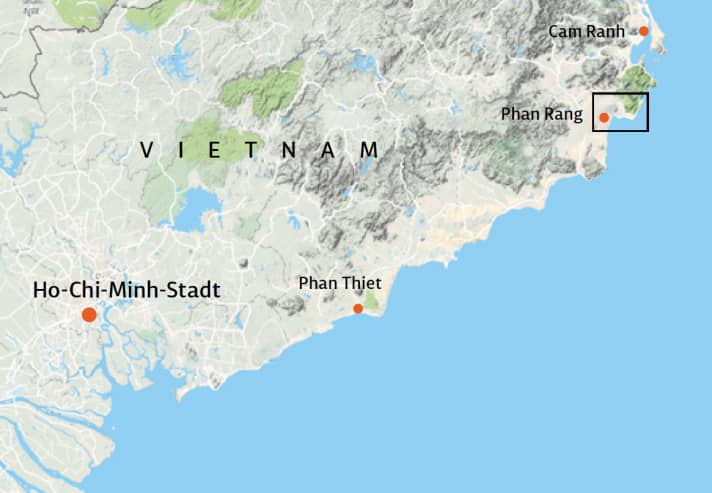
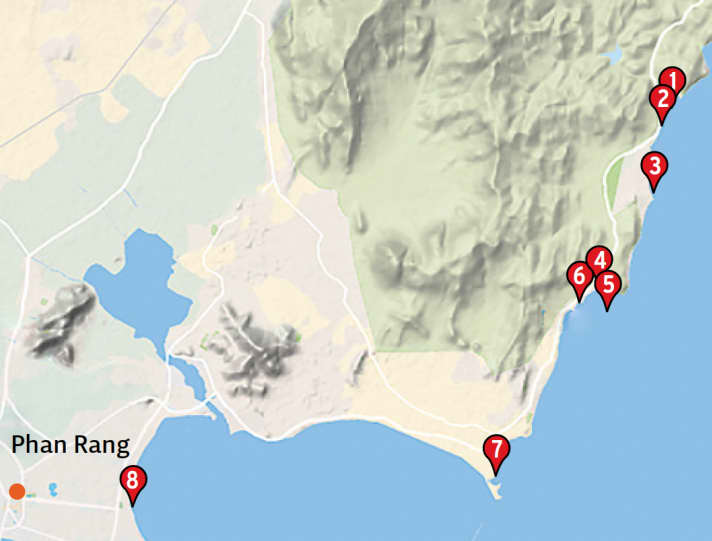
1 Thai An/Stairs
Does this advert have an official name? We don't know. We named it "Stairs" because of the steps that lead down to the beach from the main road. How to find it: From the surf camp, simply follow the main road north towards Vinh Hy. After a few kilometres, leave the village of Thai An behind you and you will see the water on your right. After a hundred metres, the steps lead down to the beach. As soon as strong winds blow from N to NNW and a solid swell hits the coast, "Stairs" is the best wave spot for pure riding in the region. From a water level of one metre, you can get in right in front of the steps, ride out over the reef and from there cruise up to the peak for about 100 metres. In the line-up, you can orientate yourself very well by an old wall on the beach. It's at this height that you can hit the wave at best and then ride it down to the channel with up to five turns. As the wind blows over a mountain from the left, the waves remain completely clean even with sideshore, there is no annoying chop, only the wind is a little gustier. On the absolute cream days, the wind turns a few degrees to the west in the evening and comes slightly offshore over the reef - perfect for riding. Due to the powerful waves, the noticeable current and the rocky bottom, Stairs is ultimately more of a spot for experienced surfers.
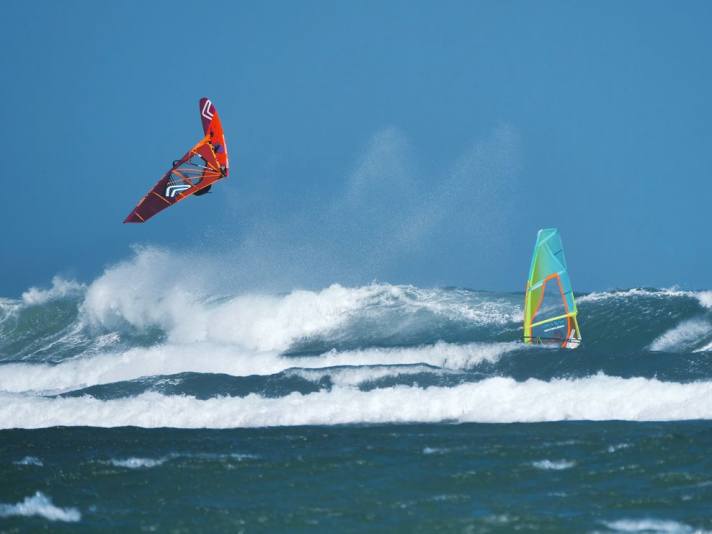
2 Thai An/Stairs Channel
Even from the road, it is easy to see that the reef of "Stairs" runs out a little further downwind, creating a deep area where no waves break. This provides perfect bump & jump conditions for practising jumps, tricks or simply cruising. The advantage of this spot is the depth of the water, because here you can start directly from the beach with short fins from a tide of 0.8 metres and don't have to worry about shallows. Inexperienced windsurfers should just be careful not to drop too far, because about two hundred metres downwind the reef becomes much shallower again and the waves start to break.
3 Thai An/North Island
A very special spot that is difficult to reach. Coming from the surf camp, turn right off the main road into the village of Thai An, then take the third road on the right, which eventually becomes a dirt track and later a sandy track. Here you have to fight your way through on a moped until you reach a grassy area directly opposite the island. There, you can rig up and go into the water. The scenery is breathtaking and beautiful, the conditions first class. Even in strong winds, the water surface remains nice and smooth, and a few smaller chops allow for jumps and freestyle tricks. But be careful! There are three large rocks in the lagoon between the land and the small island. You should only go out when the tide is 1.5 metres or higher, but even then the larger rocks are still just below the surface.

4 Skatepark
Five hundred metres upwind of the "Vietnam Surf Camping" is a unique combination spot that is equally suitable for intermediates, flat water and wave fans. Here, with NNE to ONE winds, you heat up over mirror-smooth water from the lagoon, with the occasional small wave rolling through the wide channel from the front at very long intervals - safe and yet perfect for jumping and freestyling. The further out you go, the higher the surf gets. The waves break slowly and rather gently, as the seabed rises evenly. In principle, you can ride this spot from a tide level of one metre, but if the water level is less than 1.3 metres, you have to walk out from the Vietnam Surf Camp until it is deep enough to head for the spot.
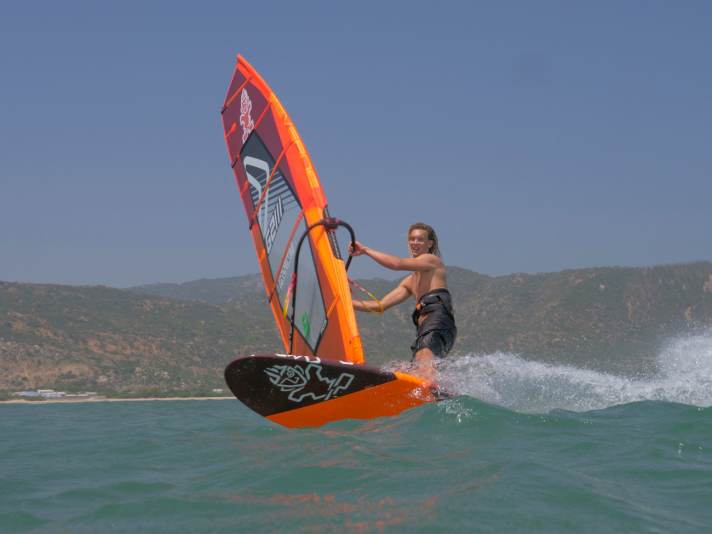
5 Surfcamp Riff
Depending on the wind strength and swell, a fast and powerful wave breaks on the reef in front of the lagoon - often only a metre high in moderate winds, but up to mast-high in long-lasting strong winds. The unrestrained sideshore wind from the left makes this spot much more suitable for jumping than "Stairs", where it is always a bit gusty in the surf zone. So, if you want to take off on every stroke and are also looking for a steep wave to ride, this is the place to be. From a water level of 1.3 metres, you can take short wave fins from the camp out through the lagoon to the reef and plunge into the waves outside, otherwise you will have to walk a little.
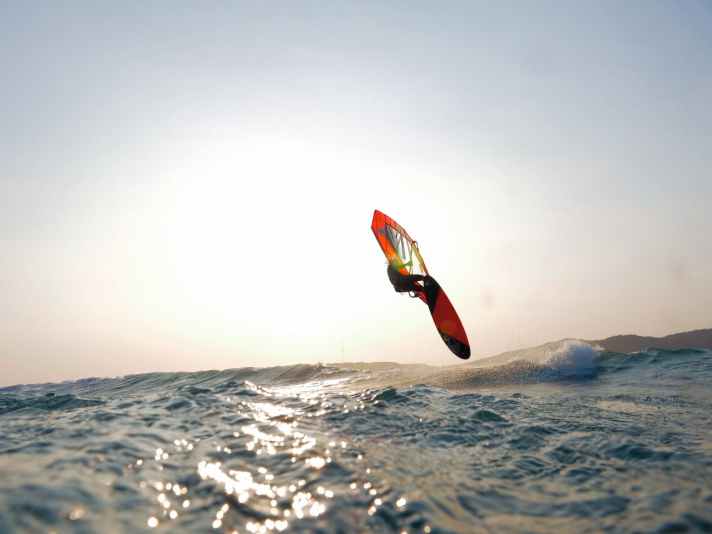
6) Surf camp lagoon
Directly in the lagoon in front of the camp, from a water level of 1.3 metres, there is a nice shallow water spot for cruising and tricks. The bottom consists of seaweed, sand and small rocks for the first two hundred metres. So if you go out with a tide of less than 1.3 metres, you risk a broken fin or a few scratches on your board. Further out, just before the reef, there are also larger stones, but these are clearly visible at low tide. So it's best to get an overview first at low tide and make enquiries on site. As a new kite centre has opened right next door, this is the only spot that you have to share with kiters, especially when the wind is weaker and training is in progress.
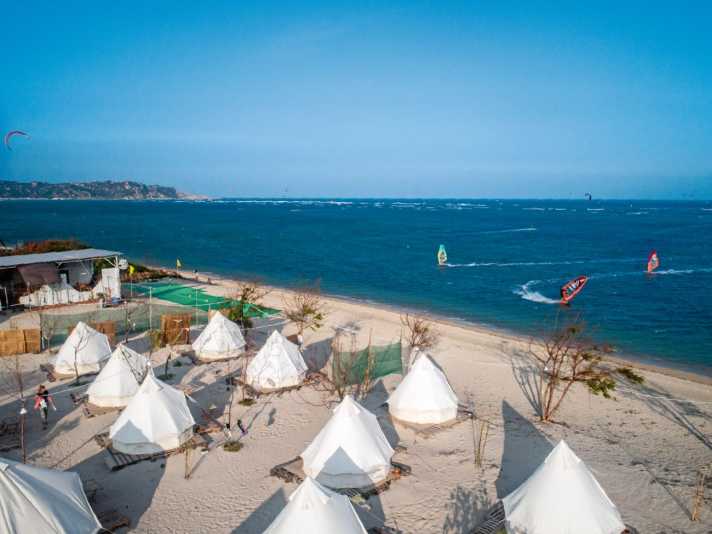
7 My Tan/South Island
You can find the spot by turning left on the main road towards My Tan just before the village and following the small road past the cemetery until you see the island off the coast. At the bottom of the beach, you can enter the water upwind of the small "harbour", the ground is very hard and stony for the first fifty metres. From a water level of over one metre you can start carefully from the shore, below one metre you should run out until it is waist deep and start from there. The wind is a little more onshore here and blows right through the gap between the mainland and the small island, which makes it even stronger. All in all, My Tan is above all a very nice spot for jumping.
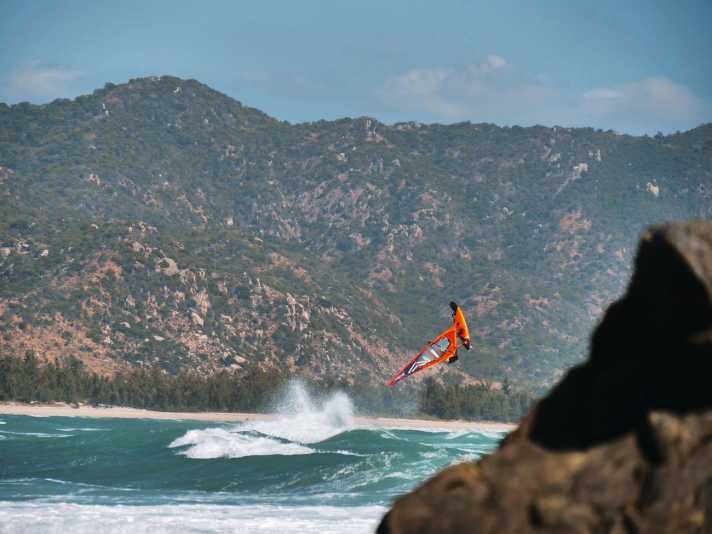
8 Phan Rang
In Phan Rang Bay, the wind is slightly weaker than at the other spots, which can also be an advantage. The wind comes side-sideonshore, but there are no big waves here, although there is a small shorebreak depending on the tide - classic bump and jump conditions. The water colour here is not as beautiful as at the spots further north due to the sandy bottom (or the sewage from the town?). However, if you don't want to spend the night in the camp but stay in one of the resorts in Phan Rang, you have the opportunity to go on the water right on your doorstep. From the main road that runs parallel to the shore through Phan Rang, turn left at the second roundabout onto a wide road with flags on the roadside. Follow this road to the beach. Caution: There may be fishing nets or lines for mooring boats. However, these can usually be easily recognised by small buoys on the surface of the water.


